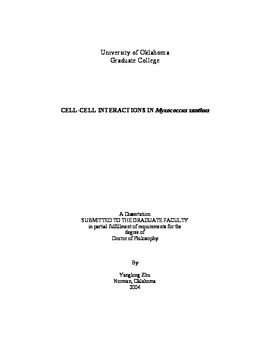| dc.contributor.advisor | Downard, John S., | en_US |
| dc.contributor.author | Zhu, Yanglong. | en_US |
| dc.date.accessioned | 2013-08-16T12:19:32Z | |
| dc.date.available | 2013-08-16T12:19:32Z | |
| dc.date.issued | 2004 | en_US |
| dc.identifier.uri | https://hdl.handle.net/11244/788 | |
| dc.description.abstract | Myxococcus xanthus, a Gram-negative, rod-shaped, nonpathogenic soil bacterium has been used as a model organism for many years for research on developmental behavior such as multicellular morphogenesis, signal transduction. This dissertation is focused on two aspects of the development. First, since M. xanthus development requires polysaccharide structures such as fibrils, a genome-wide survey of polysaccharide production genes were carried out with two methods: (1) using transposon mutagenesis to produce exopolysaccharide production-deficient mutants, then clone the genomic sequences flanking the transposon insertions for sequencing; (2) searching the M. xanthus genomic sequence database for homologs to known polysaccharide production-related genes in other organisms. Sequence analysis indicated that the transposon mutants appear to include at least two polysaccharide export systems required for exopolysaccharide production. The evidence is: (1) that many genes at separate loci, related to the type IV pilus biogenesis system such as pilQ are required for exopolysaccharide production. This is consistent with the hypothesis of pil proteins forming a general export system for polysaccharides involved in development; and (2) that some open reading frames (ORFs) around the insertion cds29 are required for exopolysaccharide production and homologous to genes such as gumB, gumC (outer membrane proteins) and rfbX (cytoplasmic membrane proteins). Considering an earlier report on the requirement of rfbABC for M. xanthus development, this seems consistent with the hypothesis of the gene products forming a polysaccharide-specific export system. This is the first indication that a polysaccharide-specific export system exists in M. xanthus. In addition to the apparent export systems, six glycosyltransferases, at least one chemotaxis gene, one chaperone gene, and a few other ORFs were identified as being required for exopolysaccharide production. Many chemotaxis genes were found to be interspersed in the putative operons of polysaccharide production-related genes. (Abstract shortened by UMI.) | en_US |
| dc.format.extent | xv, 202 leaves : | en_US |
| dc.subject | Myxococcus xanthus. | en_US |
| dc.subject | Biology, Microbiology. | en_US |
| dc.subject | Biology, Molecular. | en_US |
| dc.subject | Biology, Cell. | en_US |
| dc.subject | Cell interaction. | en_US |
| dc.title | Cell-cell interactions in Myxococcus xanthus. | en_US |
| dc.type | Thesis | en_US |
| dc.thesis.degree | Ph.D. | en_US |
| dc.thesis.degreeDiscipline | Department of Microbiology and Plant Biology | en_US |
| dc.note | Source: Dissertation Abstracts International, Volume: 65-08, Section: B, page: 3881. | en_US |
| dc.note | Adviser: John S. Downard. | en_US |
| ou.identifier | (UMI)AAI3143548 | en_US |
| ou.group | College of Arts and Sciences::Department of Microbiology and Plant Biology | |
